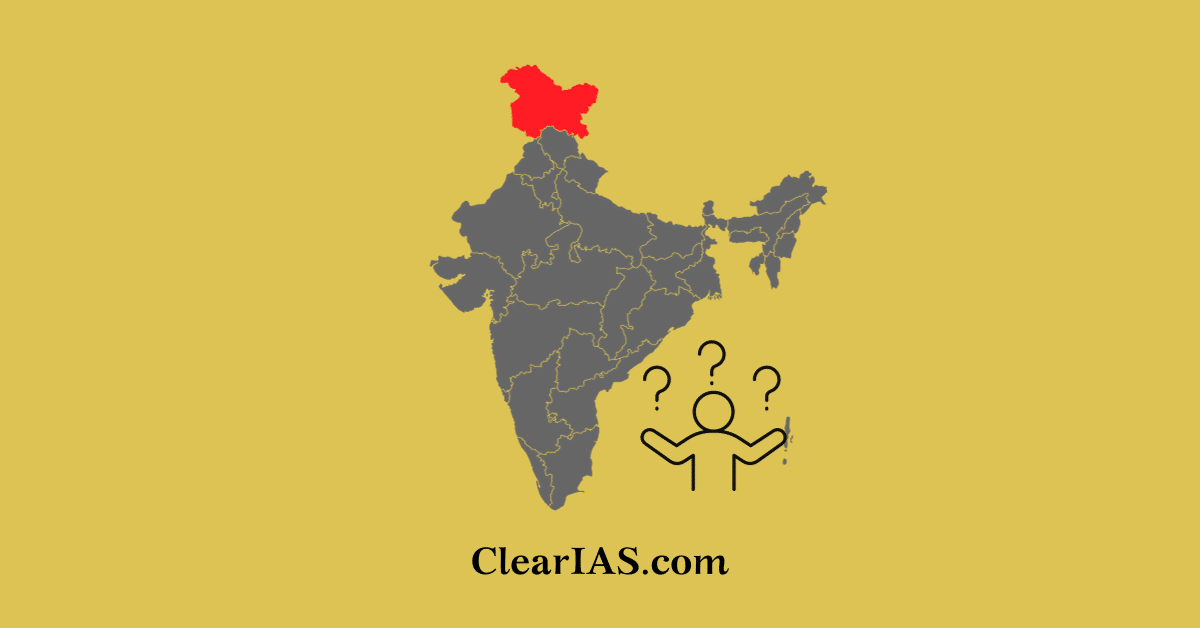
Was Kashmir an independent nation? Learn the history of Kashmir
Kashmir, and adjacent areas like Gilgit, Jammu, and Ladakh – were part of the different empires at different times. Over the years, this area was under the control of Hindu rulers, Muslim emperors, Sikhs, Afghans, and Britishers.
During the period before AD 1000, Kashmir was an important center of Buddhism and Hinduism. Many dynasties like Gonanditya, Karkota, and Lohara ruled Kashmir and surrounding areas of North-western India.
The Hindu dynasty rule which extended until 1339 was replaced by the Muslim rule by Shah Mir who became the first Muslim ruler of Kashmir, inaugurating the Shah Mir dynasty. A few centuries later, the last independent ruler Yusuf Shah Chak was deposed by the Mugul emperor Akbar the Great.
Akbar conquered Kashmir in 1587, making it part of the Mughal Empire. Subsequently, the Mughal ruler Aurangzeb expanded the empire further.
Thus, it can be seen that under the Mughal rule, which extended nearly all of the Indian subcontinent, Kashmir was an integral part of India – however, not an independent nation.
Also read: Ladakh Statehood
Kashmir Region – After the Mughals
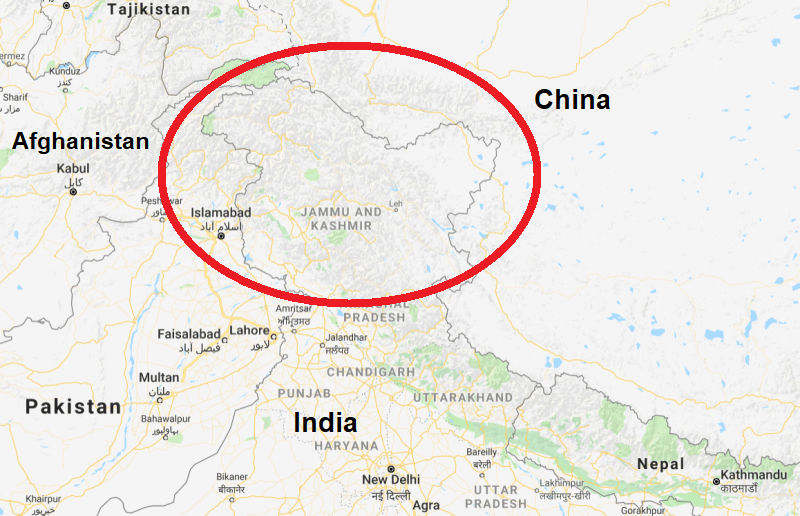
Aurangzeb’s successors were weak rulers. Later Mughals failed to retain Kashmir. After Mughal rule, it passed to Afghan, Sikh, and Dogra rule.
In 1752, Kashmir was seized by the Afghan ruler Ahmed Shah Abdali. The Afghan Durrani Empire ruled Kasmir from the 1750s until 1819 when Sikhs, under Ranjit Singh, annexed Kashmir and ended the Muslim rule.
By the early 19th century, Sikhs under Maharaja Renjith Singh took control of Kashmir. He had earlier annexed Jammu. The Sikhs ruled Kashmir until they were defeated by the British (First Anglo-Sikh War) in 1846.
After that Kashmir became a princely state of the British Empire – under the Dogra Dynasty.
Jammu and Kashmir – as a princely state of the British Empire
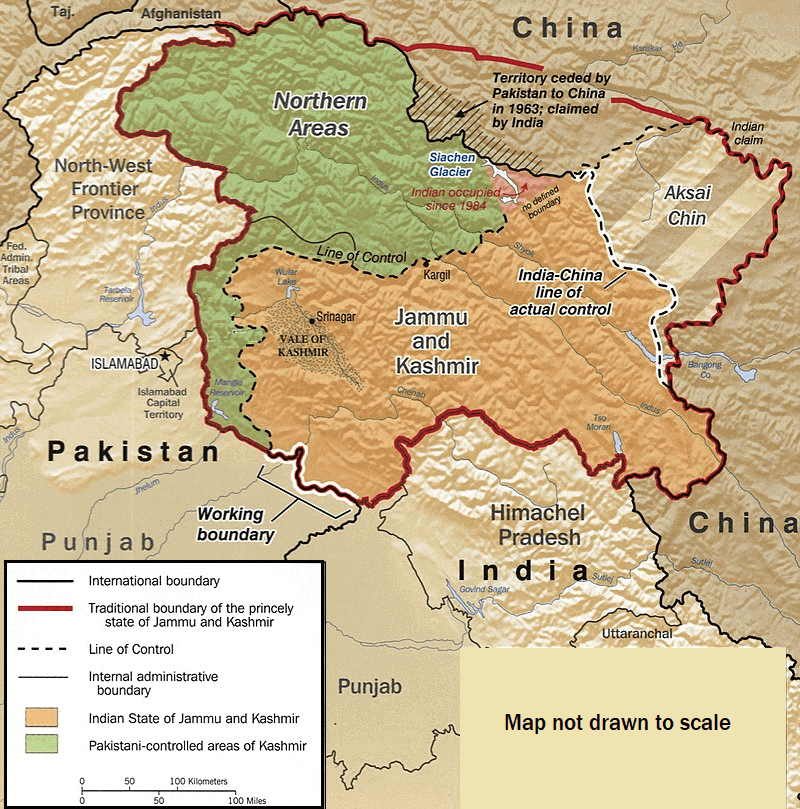
Maharaja Gulab Singh of the Dogra Dynasty signed the ‘Treaty of Amritsar’ with the British East India Company in 1846. Under this treaty, he paid Rs. 75 lakhs to the East India Company in 1846 in exchange for Kashmir and some other areas. Jammu and Kashmir as a single entity was unified and founded (1846).
Zorawar Singh, a General in the Dogra Anny later led many campaigns in the northern areas like Ladakh, Baltistan, Gilgit, Hunza, and Yagistan, consolidating smaller principalities. He expanded the dominions of Maharaja Gulab Singh.
However, Jammu and Kashmir, from 1846 until 1947, remained a princely state ruled by the Jamwal Rajput Dogra Dynasty. Like all other princely states in India then, Kashmir too enjoyed only partial autonomy, as the real control was with the British.
Also read: Special Category Status
The ruler’s stand (at the time of Partition)
During the time of partition of British India (1947), Jammu and Kashmir (J&K) was a Princely State. Britishers had given all princely states a choice – either to join India to join Pakistan or even to remain independent.
The ruler of Kashmir during that time (1947) was Maharaja Hari Singh, the great-grandson of Maharaja Gulab Singh. He was a Hindu who ruled over a majority-Muslim princely state.
He did not want to merge with India or Pakistan.
Hari Singh tried to negotiate with India and Pakistan to have an independent status for his state. He offered a proposal of a Standstill Agreement to both the Dominion, pending a final decision on the State’s accession. On August 12, 1947, the Prime Minister of Jammu and Kashmir sent identical communications to the Governments of India and Pakistan.
Pakistan accepted the offer and sent a communication to J&K Prime Minister on August 15, 1947. It read, “The Government of Pakistan agrees to have Standstill Agreement with Jammu and Kashmir for the continuation of existing arrangements …”
India advised the Maharaja to send his authorized representative to Delhi for further discussion on the offer.
What were the Kashmiri people’s aspirations in 1947?
Kashmiri people took part extensively in the Indian Nationalist Movement. They not only wanted to get rid of British rule but also never wanted to be under the rule of the Dogra dynasty once the nationalist movement achieved its mission. The Kashmiris had preferred democracy to monarchy.
Jammu and Kashmir was always a secular state – with a history of Hindu, Muslim, and Sikh rule. Even though the majority population was Muslims, it then had a significant Hindu population as well.
India in 1947 had suggested conducting a plebiscite to know the aspirations of Kashmiri people. With tall leaders of Jammu and Kashmir like Sheik Abdullah on its side, cherishing the common values – secularism, democracy, and pan-India nationalism – India was confident to win the Plebiscite if it was held in 1947.
India’s stand with Junagadh, another princely state, was also to conduct a plebiscite. In 1947, upon the independence and partition of India, the last Muslim ruler of the Junagadh state, Muhammad Mahabat Khanji III, decided to merge Junagadh into the newly formed Pakistan. The majority of the population were Hindus. The conflict led to many revolts and also a plebiscite, resulting in the integration of Junagadh into India.
However, the Pakistan attack on Kashmir in October 1947 changed all dynamics. The exact aspirations of Kashmiri People at that time is still unknown – as a plebiscite or referendum was never held.
The Pakistan Invasion of Kashmir in 1947
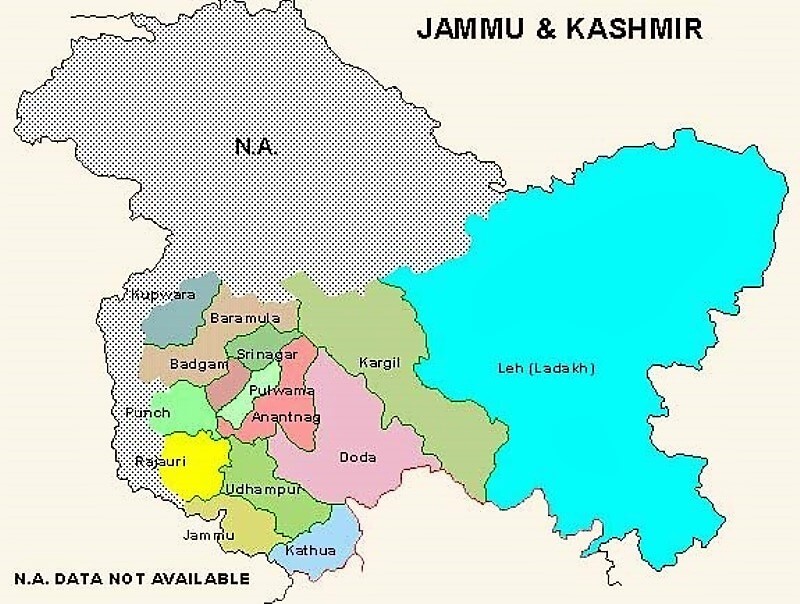
Pakistan, though entered into a Standstill Agreement with Jammu and Kashmir, had an eye on it. It broke the Standstill Agreement by sponsoring a tribal militant attack in Kashmir in October 1947.
Pashtun raiders from Pakistan invaded Kashmir in October 1947 and took control over a large area. Hari Singh appealed to the Governor General of free India, Lord Mountbatten for assistance.
India assured help on the condition Hari Singh should sign the Instrument of Accession. Maharaja Hari Singh signed the instrument of accession with India (1947). It was also agreed that once the situation normalized, the views of the people of J&K will be ascertained about their future.
Jammu and Kashmir signs the Instrument of Accession with India
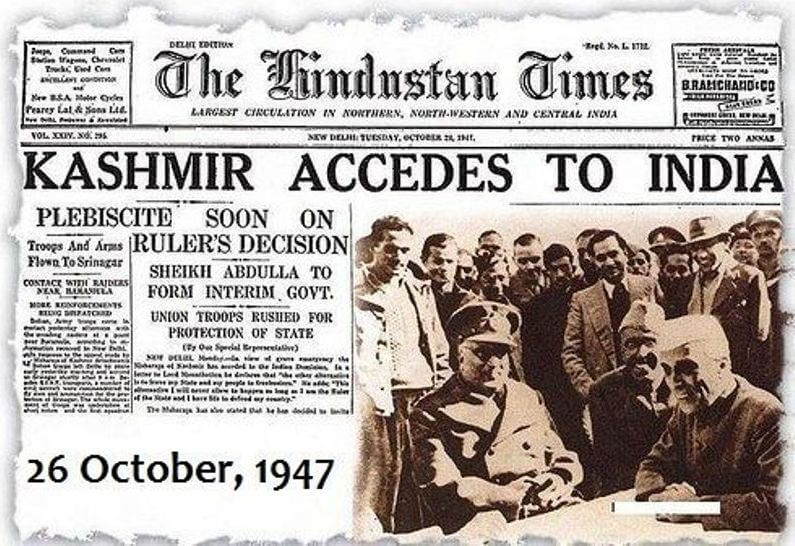
The Maharaja Hari Singh signed the Instrument of Accession to India on 26 October 1947 in Srinagar.
As soon as the accession documents were signed, the Indian Armed Force took over the stage to repulse Pakistan-supported tribal assault.
Indian and Pakistani forces thus fought their first war over Kashmir in 1947-48.
India successfully drove out most of the Pak-supported tribal militants from Kashmir occupation. However, one part of the State came under Pakistani control. India claims that this area is under illegal occupation. Pakistan describes this area as ‘Azad Kashmir’. India however, does not recognize this term. India uses the term Pak-occupied Kashmir (PoK) for the area of Kashmir under the control of Pakistan.
India brings the United Nations (UN) into the picture
India referred the dispute to the United Nations Security Council on 1 January 1948. Following the set-up of the United Nations Commission for India and Pakistan (UNCIP), the UN Security Council passed Resolution 47 on 21 April 1948.
The UN Resolution was non-binding on India and Pakistan. However, this is what the UN resolution mentioned:
UN Resolution on Jammu and Kashmir
The UN resolutions clearly said :
- Pakistan is the aggressor in the state.
- Pakistan has to vacate all occupied territory in the state and hand over the vacated territory to India.
- India has to remove all its forces leaving aside enough to maintain law and order.
- India to conduct a plebiscite in the state.
Why has no Plebiscite or Referendum been held in Kashmir yet?
- The state of Jammu and Kashmir is defined as it existed on or before the invasion of Pakistan on 22nd October 1947. This includes the present territory of Pak-occupied Kashmir (POK), Gilgit, Baltistan, Jammu, Laddhak, and Kashmir Valley.
- Pakistan asked for time to vacate its occupation but it never complied.
- As nearly one-third of the state of Jammu and Kashmir is still under the occupation of Pakistan, it is a non-compliance of conditions leading to the plebiscite.
Sheikh Abdullah’s movement – Formal incorporation of Kashmir into the Indian Union
Kashmir’s first political party, the Muslim Conference, was formed in 1925, with Sheikh Abdullah as president. Later, in 1938, it was renamed as National Conference. The National Conference was a secular organization and had a long association with Congress. Sheikh Abdullah was a personal friend of some of the leading nationalist leaders including Nehru.
National Conference started a popular movement to get rid of the Maharaja. Sheikh Abdullah was the leader.
After Maharaja Hari Singh signed an ‘Instrument of Accession’ with the Government of India, Sheikh Abdullah took over as the Prime Minister of the State of J&K (the head of the government in the State was then called Prime Minister) in March 1948.
Sheikh Abdullah was against Jammu and Kashmir joining Pakistan. However, he took a pro-referendum stance and delayed the formal accession to India. The pro-Indian authorities dismissed the state government and arrested Prime Minister Sheikh Abdullah.
The new Jammu and Kashmir government ratified the accession to India. In 1957, Kashmir was formally incorporated into the Indian Union.
Kashmir Issue – External Disputes
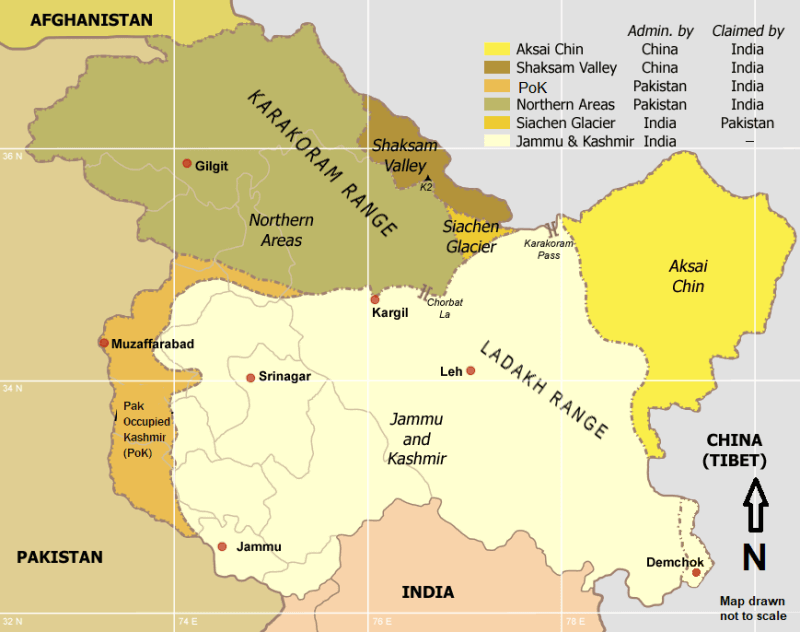
Externally, ever since 1947, Kashmir remained a major issue of conflict between India and Pakistan (and between India and China to a minor extent).
Pakistan has always claimed that the Kashmir valley should be part of Pakistan. The conflict resulted in 3 main wars between India and Pakistan – 1947, 1965, and 1971. A war-like situation erupted in 1998 as well (Kargil war).
Pakistan was not only the illegal occupant of the Kashmir region. China too started claiming parts of the princely state of Jammu and Kashmir.
By the 1950s, China started to gradually occupy the eastern Kashmir (Aksai Chin). In 1962, India fought a war with China over its encroachments, however, China defeated India. To make matters worse, Pakistan ceded the Trans-Karakoram Tract of Kashmir (Saksham Valley) to China.
Kashmir Issue – Internal Disputes
Internally, there is a dispute about the status of Kashmir within the Indian Union.
Kashmir was given autonomy and a special status by Article 370 of the Indian Constitution. Articles like 370, 371, 35A, etc are connected with privileges given to Jammu and Kashmir.
What is the special status given to Jammu and Kashmir?
- Article 370 gives greater autonomy to Jammu and Kashmir compared to the other States of India.
- The State has its own Constitution.
- All provisions of the Indian Constitution do not apply to the State.
- Laws passed by the Parliament apply to J&K only if the State agrees.
- Non-Kashmiri Indians cannot buy property in Kashmir.
This special status has provoked two opposite reactions.
A section feels that Article 370 is not needed!
There is a section of people outside of J&K that believes that the special status of the State conferred by Article 370 does not allow full integration of the State with India. This section feels that Article 370 should, therefore, be revoked and J&K should be like any other State in India.
Another section feels that Article 370 is not enough!
Another section, mostly Kashmiris, believes that the autonomy conferred by Article 370 is not enough.
Major Grievances of Kashmiris:
Kashmiris have expressed at least three major grievances.
- First, the promise that Accession would be referred to the people of the State after the situation created by tribal invasion was normalized, has not been fulfilled. They demand a ‘Plebiscite’ at the earliest.
- Secondly, there is a feeling that the special federal status guaranteed by Article 370, has been eroded in practice. This has led to the demand for restoration of autonomy or ‘Greater State Autonomy’.
- Thirdly, it is felt that democracy which is practised in the rest of India has not been similarly institutionalised in the State of Jammu and Kashmir.
Politics since 1948 – Conflict between the Kashmir State Government and the Central Government of India
After taking over as the Prime Minister, Sheikh Abdullah initiated major land reforms and other policies that benefited ordinary people. But there was a growing difference between him and the central government about his position on Kashmir’s status. He was dismissed in 1953 and kept in detention for several years.
The leadership that succeeded him did not enjoy as much popular support and was able to rule the State mainly due to the support of
the Centre. There were serious allegations of malpractices and rigging in various elections.
During most of the period between 1953 and 1974, the Congress party exercised a lot of influence on the politics of the State. A truncated National Conference (minus Sheikh Abdullah) remained in power with the active support of Congress for some time but later it merged with the Congress.
Thus Congress gained direct control over the government in the State.
In the meanwhile, there were several attempts to reach an agreement between Sheikh Abdullah and the Government of India.
Finally, in 1974 Indira Gandhi reached an agreement with Sheikh Abdullah and he became the Chief Minister of the State.
The Revival of National Conference (1977)
He revived the National Conference which was elected with a majority in the assembly elections held in 1977.
Sheikh Abdullah died in 1982 and the leadership of the National Conference went to his son, Farooq Abdullah, who became the Chief Minister.
But he was soon dismissed by the Governor and a breakaway faction of the National Conference came to power for a brief period.
The dismissal of Farooq Abdullah’s government due to the intervention of the Centre generated a feeling of resentment in Kashmir. The confidence that Kashmiris had developed in the democratic processes after the accord between Indira Gandhi and Sheikh Abdullah, received a setback.
The feeling that the Centre was intervening in the politics of the State was further strengthened when the National Conference in 1986 agreed to have an electoral alliance with the Congress, the ruling party in the Centre.
1987 Assembly Elections, Political Crisis, and Insurgency
It was in this environment that the 1987 Assembly election took place. The official results showed a massive victory for the National Conference-Congress alliance and Farooq Abdullah returned as Chief Minister.
However, it was widely believed that the results did not reflect the popular choice and that the entire election process was rigged.
A popular resentment had already been brewing in the State against the inefficient administration since the early 1980s. This was now augmented by the commonly prevailing feeling that democratic processes were being undermined at the behest of the Centre. This generated a political crisis in Kashmir which became severe with the rise of the insurgency.
By 1989, the State had come into the grip of a militant movement mobilized around the cause of a separate Kashmiri nation.
The insurgents got moral, material, and military support from Pakistan. The balance of influence had decisively tilted in Pakistan’s favor by the late 1980s, with people’s sympathy no longer with the Indian Union as it had been in 1947-48, 1965 or 1971.
The terrorists and militants drove out almost all the Hindus from the Kashmir valley, ensuring that a future plebiscite (if it happens) would be meaningless.
India imposed the Armed Forces Special Powers Act (AFSPA) in Jammu and Kashmir in 1990.
For several years, the State was under President’s rule and effectively under the control of the armed forces. Throughout the period from 1990, Jammu and Kashmir experienced violence at the hands of the insurgents and through army action.
1990 and Beyond – Growing Trust Deficit
After 1987, the pro-India sentiments of Kashmiri people tilted heavily towards Kashmiri Separatism. Pakistan, of course, added fuel to the fire – by giving moral and financial support to terrorists, militants, and insurgents. As a result, Kashmir frequently witnessed violence, curfew, stone-pelting, and firing between the troops of India and Pakistan across the Line of Control (LoC).
Thousands of soldiers, civilians, and militants have been killed in the uprising and the Indian crackdown since 1989.
Even though state elections were conducted, Kashmir did not return to normalcy before 1987.
Assembly elections in the State were held only in 1996 in which the National Conference led by Farooq Abdullah came to power with a demand for regional autonomy for Jammu and Kashmir.
J&K experienced a very fair election in 2002. The National Conference failed to win a majority and was replaced by the People’s Democratic Party (PDP) and Congress coalition government.
In 2015, India’s ruling BJP party was sworn into government in Indian-administered Kashmir for the first time in coalition with the local People’s Democratic Party, with the latter’s Mufti Mohammad Sayeed as chief minister (followed by Mehbooba Mufti because of the death of her father and party founder). However, this coalition didn’t last for long.
Even though the Government of India is taking many steps to stop the insurgency and bring Kashmir back to normalcy, terrorist attacks like that in Pulwama have seriously hindered the peace process.
The Current Stand of India – Regarding the Kashmir Question
- No more mediation with the UN or any other other third parties.
- India and Pakistan should resolve issues through bilateral talks as agreed by the Simla Agreement.
- No Plebiscite in Kashmir unless Pakistan reverses the situation back to what was in 1947 (territory and demographics).
Who are the Kashmir Separatists?
- All Parties Hurriyat Conference
- Jammu Kashmir Liberation Front
- Harkat-ul-Jihad al-Islami
- Lashkar-e-Taiba
- Jaish-e-Mohammed
- Hizbul Mujahideen
- Harkat-ul-Mujahideen
- Al-Badr
- Ansar Ghazwat-ul-Hind Flag.png Ansar Ghazwat-ul-Hind (Since 2017)
What do Separatists demand?
Separatist politics which surfaced in Kashmir from 1989 has taken different forms and is made up of various strands.
- There is one strand of separatists who want a separate Kashmiri nation, independent of India and Pakistan.
- Then some groups want Kashmir to merge with Pakistan.
- Besides these, there is a third strand which wants greater autonomy for the people of the state within the Indian union.
Demand for intra-state autonomy
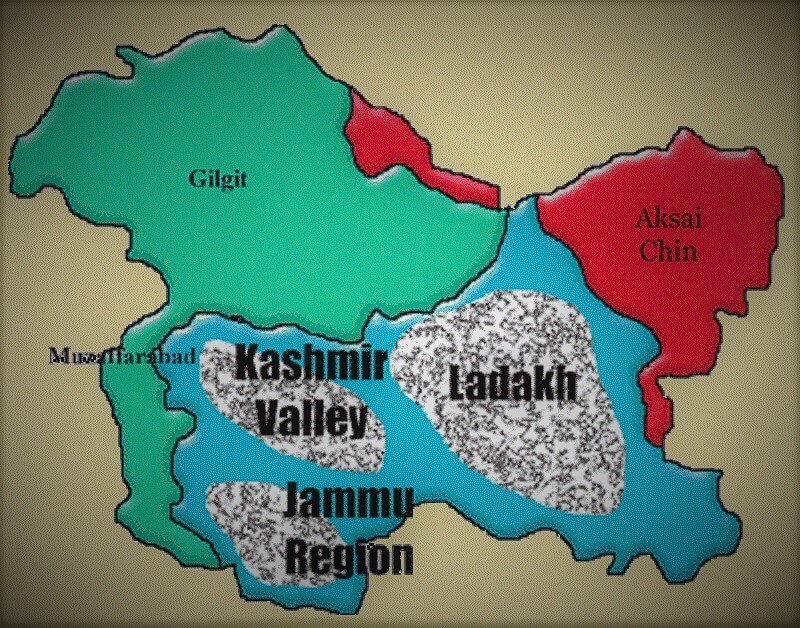
Even though the name of the state is Jammu and Kashmir (J&K), it comprises three social and political regions: Jammu, Kashmir, and Ladakh.
- Jammu – The Jammu region is a mix of foothills and plains, of Hindus, Muslims, and Sikhs and speakers of various languages.
- Kashmir – Kashmir Valley is the heart of the Kashmir region. The people are Kashmiri-speaking and are mostly Muslims. There is also a small Kashmiri-speaking Hindu minority.
- Ladakh – The Ladakh region is mountainous, and has a very small population which is equally divided between Buddhists and Muslims. Ladakh is divided into two main regions – Leh and Kargil.
It should also be noted that out of the 3 main administrative divisions – Jammu, Kashmir, and Ladakh – insurgency and demand for independence is high only in the Kashmir Valley. Most of the people in Jammu and Ladakh still wish to be part of India, even though they demand autonomy differently. They often complain of neglect and backwardness. The demand for intra-state autonomy is as strong as the demand for State autonomy in the regions of Jammu and Ladakh.
Article 370: Changes made via Presidential order of 2019
On 5 August 2019, Home Minister Amit Shah announced in the Rajya Sabha (upper house of the Indian Parliament) that the President of India had issued The Constitution (Application to Jammu and Kashmir) Order, 2019 (C.O. 272) under Article 370, superseding the Constitution (Application to Jammu and Kashmir) Order, 1954.
The order stated that all the provisions of the Indian Constitution applied to Jammu and Kashmir.
While the 1954 order specified that only some articles of the Indian constitution to apply to the state, the new order removed all such restrictions.
This in effect meant that the separate Constitution of Jammu and Kashmir stood abrogated.
The President issued the order with the “concurrence of the Government of State of Jammu and Kashmir”, which meant the Governor appointed by the Union government.
Change of status: Jammu and Kashmir Reorganisation Act, 2019
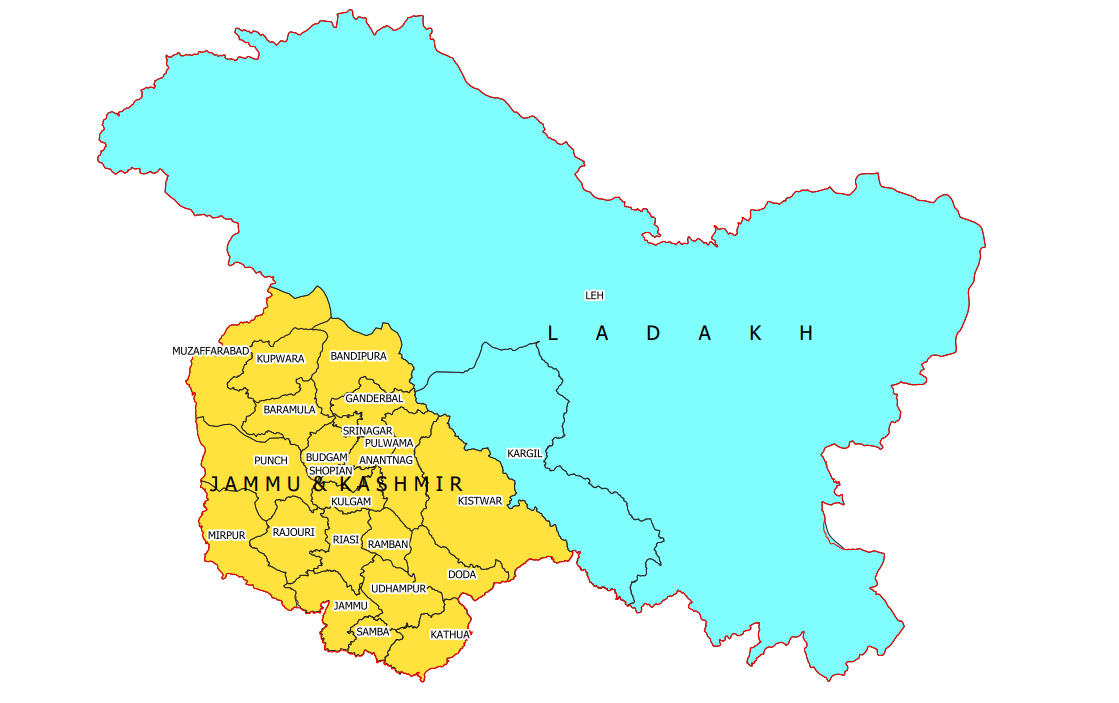
After the Government of India repealed the special status accorded to Jammu and Kashmir under Article 370 of the Indian constitution in 2019, the Parliament of India passed the Jammu and Kashmir Reorganisation Act, which contained provisions that dissolved the state and reorganized it into two union territories – Jammu and Kashmir in the west and Ladakh in the east.
The two union territories came into existence on 31 October 2019, which was celebrated as National Unity Day.
The union territory of Jammu and Kashmir was proposed to have a legislature under the bill whereas the union territory of Ladakh is proposed to not have one.
Urge for Peace
The initial period of popular support for militancy has now given way to the urge for peace.
The Centre has started negotiations with various separatist groups. Instead of demanding a separate nation, most of the separatists in the dialogue are trying to re-negotiate a relationship of the State with India.
Conclusion
The Kashmir issue – has multiple dimensions – external and internal; inter-state as well as intra-state. Not even the separatists are on the same ground – their demands are different.
The princely state of Jammu and Kashmir which was under the control of British India – is now not entirely with India. Pakistan and China too now occupy a significant portion of the territories of the erstwhile princely state.
Of course, the Kashmir problem also includes the issue of Kashmiri identity known as Kashmiriyat. However, almost every state in India has its own identity – Tamil Nadu, Karnataka, West Bengal, or Kerala. However, the people in each of these states even when seeing themselves as Tamilians, Kannadagans, Bengalis or Malayalis are also able to see the bigger picture – they identify themselves as Indians.
Jammu and Kashmir is one of the living examples of plural society and politics. Not only are there diversities of all kinds (religious, cultural, linguistic, ethnic, tribal) but there are also divergent political aspirations.
Unfortunately, from the perspective of the youth of Kashmir, there is a growing trust deficit. It’s a hard reality that Jammu and Kashmir never functioned like other Indian states since its accession to India. It had given higher autonomy initially, however, it got eroded in practice.
The first step to solving the Kashmir issue is to identify the problems behind the alienation of Kashmir. Here are some of them:
- Mishandling of the Kashmir Issue by the successive Central governments of India – which includes frequent dismissal of State Assemblies.
- The state governments of Kashmir failed to distribute the benefits of growth and development to every area of Kashmir.
- The terrorist and military outfits in Pakistan have been distancing the youth of Kashmir from the democratic form of the Indian government.
- The regular presence of the Indian Armed Force or CAPF in the Kashmir interiors, and the misuse of provisions like ASFPA.
To find a solution to the Kashmir issue – all stakeholders should be considered.
What is the need of the hour is proper integration of Kashmir, Jammu, and Ladakh with India. Integration should not be seen in a limited dimension of territory. India should be able to win the hearts of the people of Kashmir.
Only time can tell about the success of the changes made concerning the provisions of Article 370.
Kashmir was and still is an integral part of India. It has a plural and secular culture – just like the rest of India. Urgent steps should be taken to bridge the gaps of trust deficit in the minds of Kashmiri youth. All Kashmiris should get the due share in the growth story of India. Like all other states in India, there should be adequate political autonomy in Jammu and Kashmir.
Violence, terrorism, and killings are never the answer – be it on any side. What do you think?
Read:





The separatist themselves don’t want this situation to have a positive outcome as it will subsequently deteriorate/hamper their “political” stance which they’ve nurtured since a long time.
I never seen a article like this…its amazing date wise i m from Kashmir i nvr understand Kashmir isssue , Kashmir history from beginning…but today i understand full 🌝 thanks to the author of this article 😊
As long as radical brainwashed of youth continues…nothing can be done, first shut down all those radical institutions & then bring education that teaches about secularism & India’s beauty & achievements!
kashmiri youth mind are washed out by these separatist…and some militant group ..work opportunity should be given to the youths of kashmir alike other states of india ….Empty mind see only a way to destruction…..
The real situation of J&K can be assessed only by hearing the voices of the common people, the constitutional arrangements like Article 370, Article 35A & IoA must be respected to keep the relationship intact.
Common people with normal situation ab toh majority Muslim log ka hi hai…. pehle un hinduwo ko bulo jinko waha se bhga diya gya …tb na brabar ka faisla hoga
there is another angle to look into this dispute and that is religion. religion play a major role in building and developing the behaviour of the society.
Yes, I do agree that wars, disputes, killing will no longer be a way to provide an efficient solution to Kashmir issue.
wonderful article….!! what i believe is ..us Indians should stand together for Kashmir… and make people of Kashmir know that though we are 1000’s of kilometers away we still stand for them will be their strength…Apart from all the political drama they should know that a simple spark in kashmir will cause a wildfire in kanyakumari.. The role of govt here is the root cause of all the issues if u ask me .. what were you doing while the kidnapper lure the kid with the candy …? now indian govt should respect the kashmiri’s give them the hope and gain trust.. a lot of bloodshed ,mutilated bodies , power abuse , women abuse … give them hope …show them we love them .. youth from other states understand the kashmiris show them the support.. show them why they should be a part of india …
For the violence to stop in Kashmir and preventing this problem to further aggravate development plans, projects should be well reached in the state so that the youth is engaged in something productive rather than destructive work. First of all, the politicisation of the State situation should be avoided.
This is not the solution of problem,but give the right of people.As it is mentioned is article that Kashmir was a princely state,it has right to what they want,the Kashmir dispute has only one solution come India and Pakistan forward and give rights to Jammu and Kashmir people what they want,and destroy this illegal occupied.
Further plubicite may useful for kashmiris yo choose their will…
Your assumption of Kashmir being an integral part of India because the it was a part of The Mughal Empire is akin to the assumption that India is an integral part of Great Britain because it was a British colony once. That is ridiculous!
The problem would not be solved till India accepts the fact that Kashmir is not an integral part of India. You cannot blame Pakistan for it then because Pakistan was as much ‘India’ once as new India is. So morally, historically, Politically and logically, by your argument, Pakistan is nowhere wrong to claim Kashmir for itself!
but chirag The Government of Pakistan agrees to have Standstill Agreement with Jammu and Kashmir but india didn’t. So, Pakistan is wrong as it was a the first one who attack….in 1947 october after that indian government helps J&K and our military took over the charge.
state politician are taking due benefit of the prevailing situation in jammu kashmir. They are making their vote bank at the cost of common public. Center should make efforts to ground level development through job creation employment generation education and overall development of state. mare education is not solution even the highly educated students after getting no source of income has diverted their route which mislead the other growing youth. Stone pelting is source of income for some public because they are paid for this for which politicians and other extremists are responsible as they bargain with center for normalcy of situation.
all is messed up because of british government gave 3 choice instead of two
Very good article, Alex! 🙂
The only thing matters is that J&K belongs to India, anyone can claim it but won’t get even a stone of it. (At least till the plebiscite is done with all the Kashmiris taking part including the one who had left or removed from Kashmir). They do deserve to take their own decision with all due respect but including all the Hindus, Muslims, Sikhs and Buddhists.
This is the best article I have ever read……!!! Really helpful in making a notes on Kashmir…..Thankyou very much…..!!!!!!
Now the minds of kashmir people have been washed with the continuous presence of separatists and the Pak sponsored terrorism. No more plebiscites are needed to be given to these people. Indian government and the constitution is supreme. They have revoked 370 to bring the J & K into mainstream for all round development of J&K and its people. Pak does not have any right to interfere in our affairs, since its accession to India.
Really good notes, grateful thanks to clearias team
If Indian government wanted to integrated Kashmir into Indian Union, they should behave like human towards Kashmiri people who suffered from torture, disappearance, rapped by Indian Army from decades. Even Kashmiri youth experience torture, mob lynching by rest of indian people and although India wanted to integrate land of Kashmir not the people.
Can I download all of this in pdf format?
Thank you sir
It’s a very good article and has explained the J&K issue as easily as possible yet maintained the details. My look over the recent amendments on the J&K issue has changed, and it looks like a step that will work for the people in the long run (however not in the short term).
Now come to know more about J & K issue…
Contents of several book in one article..
Separatists,militants,terrorists, defunct politicians should be treated hard with central / State agencies …
Hope for peace not only in valley…
But in all parts including jammu,Kashmir & Ladakh……
I have a simple question. Even if both Pakistan and India want and agree on something. Should that be the solution, or should it be what the people want.
To me, whether you like it or not, its the right of the Kashmiris to decide what they want for their future. Give them that right, thats the only fair solution.
And if you are not bothered by what is fair then the alternative is to go with the powerful and war is the way to find who is stronger.
This Article is Baseless and Far From Ground Reality of Our Kashmir Nation , Kashmir Is not a integral or Vein of Any Nation wether is India or Pakistan , Kashmir Is Independent Before Birth of India or Pakistan.. Due to Continues occupation by Non Kashmirs Wehter is Muslim or Non Muslims , We Kashmirs Fight against the Occupation From years, still we are under Occupation joinlty by India paksitain and China ,, We Kashmirs are Peaceful Community between three Nation , we Lost more then 1 lakh we are wintess of crimes done by Non Kashmirs, we kashmiri Never agaist any Pakistain or India , but we never allow any indian or pakitain Interfercne in out kashmir , due to interference of India and Pakistan is responsible for destruction of our kashmir nation , We Peaple of kashmir never accept any occupation , 1000 political Drama playing by tri nation till date in our kashmir..
we Kashmiri appeal to Good and responsible Citizen of India and Pakistaini , both-side people are misguided regarding the Kashmir nation, the Ground Reality is different..
we Kashmiri respect both side nation as guest , we welcome every country peoples visit our kashmir people but we never accept India and pakistain occupation and we never forget the crimes of India and pakistain .
Please update your notes. This is brilliantly done.
Unbiased, good analysis and effectively presented. Hope the powers to be can affect the policy ideas presented here. Thanks!
The post “Kashmir Issue – Understand the multiple dimensions” on ClearIAS offers a comprehensive and balanced overview of the complex history and current challenges surrounding Kashmir. Its clear and concise presentation makes it accessible to readers seeking to grasp the multifaceted aspects of the issue. This piece is a valuable resource for anyone looking to deepen their understanding of the Kashmir conflict.